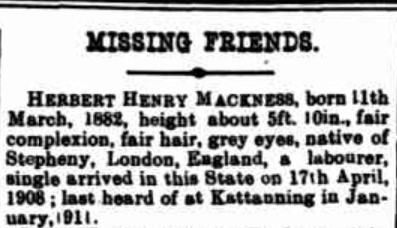Herbert MACKNESS
Eyes grey, Hair dark, Complexion dark
Herb Mackness
Can you help us identify Herb?
Herb was killed in action at Fromelles. As part of the 32nd Battalion he was positioned near where the Germans collected soldiers who were later buried at Pheasant Wood. There is a chance he might be identified, but we need help. We are still searching for suitable family DNA donors.
In 2008 a mass grave was found at Fromelles, a grave the Germans dug for 250 (Australian) bodies they recovered after the battle.
If you know anything of contacts for Herb here in Australia or his relatives from Essex, England, please contact the Fromelles Association.
See the DNA box at the end of the story for what we do know about his family.
Early Life
Herbert Henry Mackness, also known and spelled as McNess, was born in Stepney London, England on 11 March 1882 to parents Henry William and Emma Rebecca Mackness (nee Patmore). They had been married at St Thomas, Mile End Old Town, Stepney in December 1880. Herb was the oldest child and he had six sisters:
- Elizabeth Esther 1884 – 1902
- Edith 1886 – 1948
- Kate Eliza 1890 -
- Annie May 1891 -1961
- Alice 1896 – 1985
- Nellie Gertrude 1900 – 1900.
Herb’s father worked as a solicitor’s clerk and a postman and his Grandfather William ran a bakery on Commercial Road, East London. Herb attended the Colegrave Road School, Stratford London. After his schooling Herb was employed as a railway porter. Herb decided to emigrate to Australia when he was 25, leaving England aboard the ship Orontes. He arrived in Fremantle, Western Australia in May 1908. His movements in Western Australia are not well known. However, there were several newspaper articles in March 1912 that place him at Katanning, a farming region southeast of Perth.
It accurately describes Herb’s birthday and being from Stepney London and states that he had been working as a labourer in Katanning in January 1911, but the article is titled “Missing Friends”. It is not known if Herb was located by the person who placed the notice in the newspapers.
Herb’s 1915 enlistment papers state that he was from Wickepin, 140 km north of Katanning.
Off to War
Herb had his medical at Wickepin on 7th July 1915, was declared fit for service on enlistment into the A.I.F and was assigned to the newly formed 32nd Battalion, C Company. He recorded his next of kin as his sister Edith McNess, Manor Park, Essex, England. On 21 July 1915 he went to the Blackboy Hill training camp at Helena Valley to begin his basic training.
The 32nd was made up of C and D Companies from Western Australia and A and B Companies from South Australia. Herb sailed from Fremantle to Adelaide in September where the full Battalion was assembled before departing Australia on 18 in November aboard HMAT Geelong A2.
As reported in The Adelaide Register:
“The 32nd Battalion went away with the determination to uphold the newborn prestige of Australian troops, and they were accorded a farewell which reflected the assurance of South Australians that that resolve would be realized.”
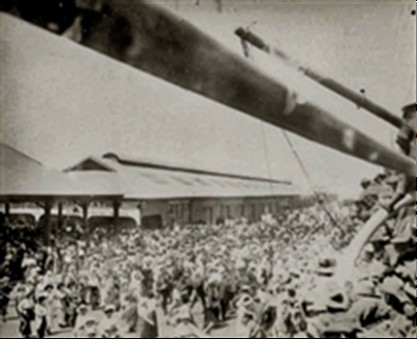
Herb arrived in Suez on 14 December 1915 and moved to El Ferdan just before Christmas. A month later they marched to Ismailia, then to Tel el Kebir for February and most of March. The next stop was at Duntroon Plateau and Ferry Post until the end of May, training and guarding the Suez Canal. Their last posting in Egypt was a few weeks at Moascar. One soldier’s diary complained of being “sick up to the neck of heat and flies”, of the scarcity of water during their long marches through the sand and he described some of the food as “dog biscuits and bully beef”.
He did go on to mention good times as well with swims, mail from home, visiting the local sights and the like. Source AWM C2081789 Diary of Theodor Milton PFLAUM 1915-16, page 29, page 12 . You can read Theodor’s Soldier Story here. During their time in Egypt the 32nd had the honour of being inspected by H.R.H. Prince of Wales.
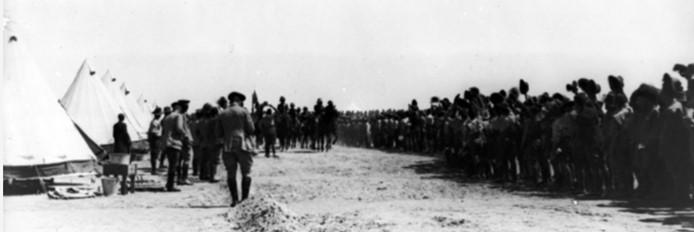
Fromelles
After spending six months in Egypt, the call to support the British Expeditionary Force on the Western Front came in mid-June. They left from Alexandria aboard the ship Transylvania on 17 June 1916 and arrived at Marseilles, France on 23 June 1916. They then had a two-day train trip to Steenbecque. Their route took them to a station just out of Paris, within sight of the Eiffel Tower, through Bologne and Calais, with a view of the Channel, before they disembarked and marched to their camp at Morbecque, about 30 kilometres from Fleurbaix.
Theodor Pflaum (No. 327) wrote about the trip in his diary:
“The people flocked out all along the line and cheered us as though we had the Kaiser as prisoner on board!!”
Wesley Choat (No. 68), for one, was glad to be out of Egypt, but he was well aware of what laid ahead:
“The change of scenery in La Belle France was like healing ointment to our sunbaked faces and dust filled eyes. It seemed a veritable paradise, and it was hard to realise that in this land of seeming peace and picturesque beauty, one of the most fearful wars of all time was raging in the ruthless and devastating manner of "Hun" frightfulness”.
Training continued with a focus on bayonets and the use of gas masks, assuredly with a greater emphasis given their position near the front.
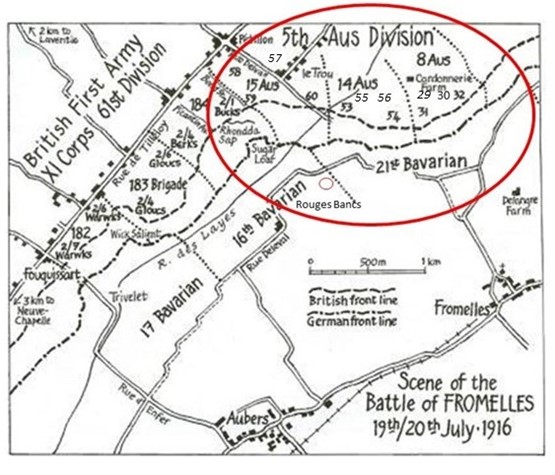
The 32nd moved to the front on 14th July and they were into the trenches for the first time on 16 July in preparation for an assault on the German trenches at Fromelles…only three weeks after arriving in France. On the 17th they were reconnoitering the trenches and cutting passages through the wires, preparing for an attack, but it was delayed due to the weather.
D Company’s Lieutenant Sam Mills’ letters home were optimistic for the coming battle:
“We are not doing much work now, just enough to keep us fit—mostly route marching and helmet drill. We have our gas helmets and steel helmets, so we are prepared for anything. They are both very good, so a man is pretty safe.”
The plan was to use Brigades from the Australian Fifth Division to conduct a diversionary assault of the German trenches at Fromelles. The Australian 8th Brigade were to attack the German trenches on the left flank crossing only 100 metres of No Man’s Land to reach the trenches. The 32nd was on the extreme left flank, which made their job more difficult, as, not only did they have to protect themselves while advancing on the German lines they had to block off the Germans on their left, to stop them from coming around behind them.
All were in position by 5.45 PM and the charge over the parapet began at 5.53 PM. A Company and Herb’s C Company were the first and second waves to go, B & D the third and fourth. They were successful in their initial assaults and by 6.30 PM were in control of the German’s 1st line system (map Trench B), which was described as:
“practically a ditch with from 1 to 2 feet of mud and slush at the bottom”.
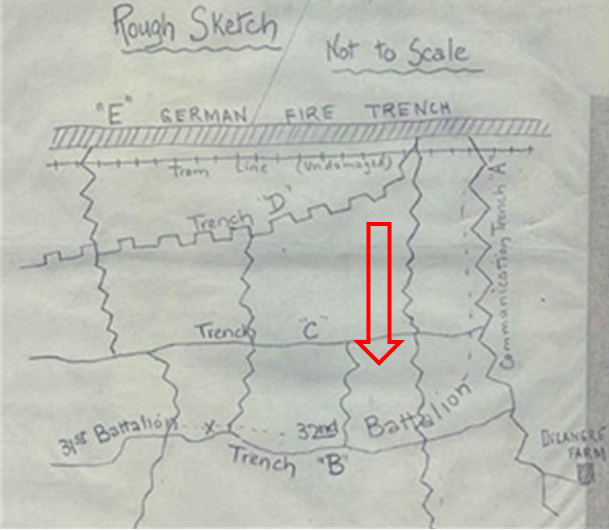
Unfortunately, with the success of their attack, ‘friendly’ artillery fire caused a large number of casualties. They were able to take out a German machine gun in their early advances but were being “seriously enfiladed” from the machine guns at Delangre Farm on their left flank. By 8.30 PM their left flank had also come under heavy bombardment with high explosives and shrapnel. Return bombardment support was provided and the 32nd was told that:
“the trenches were to be held at all costs”.
With the 32nd Battalion suffering heavy casualties from continued German counter attacks during the night, the German infantry were able to penetrate the gaps in the Australian lines. The Australians maintained their positions until about 3.45am when the Germans began an attack from the Australian’s left flank, bombing and advancing into Trench A (map).
Given the Australian advances that had been made earlier, the rear Trench E had been left almost empty, which then enabled the Germans to be in a position to surround the soldiers of the 32nd. At 5.30 AM the Germans attacked from both flanks in force and with bombing parties. Having only a few grenades left, the only resistance they could offer was with rifles:
“The enemy swarmed in and the retirement across No Mans’ Land resembled shambles, the enemy artillery and machine guns doing deadly damage.”
What was left of the 32nd had finally withdrawn by 7.30 AM on the 20th. The initial roll call count was devastating – 71 killed, 375 wounded and 219 missing. To get some perspective of the battle, when Charles Bean, Australia’s official war historian, attended the battlefield two and half years later, he observed a large amount of bones, torn uniforms and Australian kit still on the battlefield. The final impact was that 225 soldiers of the 32nd Battalion were killed or died from wounds sustained at the battle and, of this, 166 were unidentified.
Lieutenant Sam Mills survived the battle. In his letters home, he recalls the bravery of the men:
“They came over the parapet like racehorses……… However, a man could ask nothing better, if he had to go, than to go in a charge like that, and they certainly did their job like heroes."
Herb’s Fate
Herbert’s fate is unknown as there are no witnesses or reports on how far he may have been able to advance. His ID tags had not been recovered by the Australians or the Germans. He was initially reported as “missing in action”. In September 1916, his mother wrote to ‘Carlton House Terrace’ for any news on her missing son. The last letter she had from Herb was dated 6 July saying that he had arrived in France.
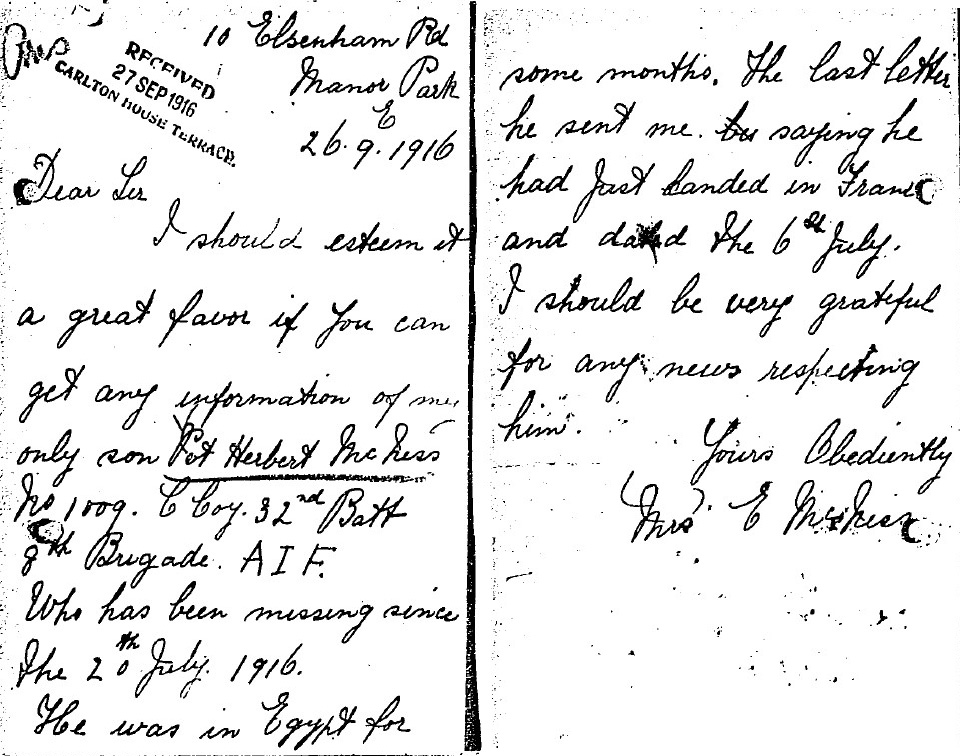
The Army response was that they regretted to inform her that they had no news of her missing son. A court of inquiry held in the field on 12th August 1917 pronounced that Private Herbert Henry Mackness of 32nd Battalion C Company was as killed in action on 20th July 1916. He has no known grave. He was awarded the 1914-15 Star Medal, the British War Medal, the Victory Medal and a Memorial Plaque and a Memorial Scroll.
Herb is commemorated at VC Corner Australian Military Cemetery, Fromelles France, Australian War Memorial, Canberra, Wickepin District Roll of Honour and Wickepin Fallen Soldiers Memorial
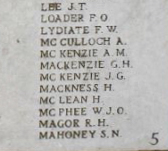
Could Herb Still be Found?
In 2008 a mass grave was found at Pheasant Wood, Fromelles, a grave the Germans dug for 250 (Australian) bodies they recovered after the battle. As of 2024, 180 of the 250 soldiers, including 41 of the 166 missing soldiers from the 32nd, have been identified from the grave by DNA matching from family member donors. It is possible that Herb could be one of the yet unidentified 70 soldiers. If you know anything of related folk with the surname of Patmore or Mackness in Australia or from Essex, England, please contact the Fromelles Association.
As of October 2024, we have been unable to locate any family of Herbert Mackness. Thus, we have been unable to provide him, with his chance of identification. Specifically family connections with the names of Mackness and Patmore are sought.
| Soldier | Herbert Henry Mackness (1882-1916) |
| Parents | Henry William Mackness (1859-1837) b Stepney UK, d East Ham Essex and Emma Rebecca Patmore |
| Siblings | Elizabeth Esther (1884 – 1902) b Stepney England, d West Ham England | ||
| Edith (1886 – 1948) b Stratford West Ham, England, d East Ham England, m Arthur John Thorne | |||
| Kate Eliza (1890 - ) b Stratford, West Ham England | |||
| Annie May (1891 -1961) b Stratford England, m Wilfred Gilbey Andrews | |||
| Alice (1896 – 1985) b Stratford England, d Southend On Sea England, m Henry William Naroborough | |||
| Nellie Gertrude (1900 – 1900) b East Ham England, d Southend On Sea England |
| Grandparents | |||
| Paternal | Wiliam Mackness (1825-1914) b Holme Huntingdonshire England, d Essex England and Ann Eliza Keighley (1841-1908) b Middlesex England, d West Ham England | ||
| Maternal | Henry Peter Keighley (1813-1885) b St Pancras England, d Stepney England and Eliza (1798-1879) |
The Fromelles Association would love to hear from you

Contacts
(Contact: carla@fromelles.info or geoffrey@fromelles.info).
(Contact: army.uwc@defence.gov.au or phone 1800 019 090).
Donations
If you are able, please contribute to the upkeep of this resource.
(Contact: bill@fromelles.info ).

